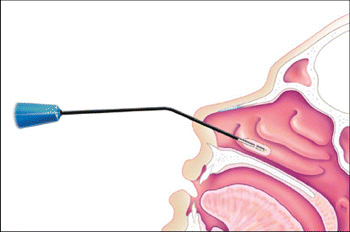Hypertrophy of the inferior turbinates is a frequent cause of chronic nasal obstruction. In the last several years, two new techniques have become available for reducing the tumor volume: radiofrequency volumetric tissue reduction (RFVTR) and coblation. As more data become available, clinical researchers are finding that the techniques work well, are safe, and have fewer short-term side effects than traditional surgical submucosal resection.
Explore This Issue
June 2006The Techniques
With RFVTR, also called Somnoplasty (Gyrus ENT), the physician inserts the probe into the head of the turbinate so that the active tip is completely submucosal. The treatment time and amount of energy delivered can be selected by the physician, with the maximal tissue temperature reaching 60° to 90°C. The energy creates a lesion in the meaty part of the turbinate and causes necrosis or coagulation of the tissue, shrinking it from the inside over the course of the next four to six weeks, said Neil Bhattacharyya, MD, Associate Professor of Otology and Laryngology at Brigham and Women’s Hospital in Boston, Mass.
Coblation (ArthroCare Corporation) is similar but the probe is slightly larger and the way the energy is delivered is somewhat different. The probe is inserted and vaporizes tissue within 0.5 mm of the probe surface with radiofrequency current. The energy from the probe also heats immediately adjacent tissue to 40° to 70°C, but the thermal lesion is smaller than in RFVTR.
As more data become available, clinical researchers are finding that the techniques work well, are safe, and have fewer short-term side effects than traditional surgical submucosal resection.
Both procedures can be performed in the office with local anesthesia. Dr. Bhattacharyya estimated that it takes him about 45 seconds with RFVTR and 10 seconds per pass with coblation. He often does several passes with the coblation probe, however.

In his experience, coblation results in somewhat faster symptomatic improvement for patients than occurs with RFVTR. On the other hand, he finds that patients feel the coblation more, so if he has a nervous patient, he’ll opt for RFVTR.
Long-Term Outcomes for RFVTR
In the first long-term study on either radiofrequency technique published thus far, Greg A. Krempl, MD, a physician and Clinical Researcher in the Department of Otorhinolaryngology at Oklahoma University Health Sciences Center in Oklahoma City, and colleagues found that the symptomatic benefits from RFVTR were maintained through two years. The authors reported the follow-up data in the April 2006 issue of The Laryngoscope.
Leave a Reply